OntoIMM: An Ontology for Product Intelligent Master Model
Abstract
1. Introduction
- (1)
- Lack of representation of know-how and know-why information and knowledge about product and its development process that facilitates design decision-making and the completeness of know-what information. CPM mainly focus on capturing know-what information of an artifact, such as requirement, function, behavior, and form, while lacking the organization of know-why and know-how knowledge. However, the acquisition and fusion of design knowledge is the key of the main enhancement of rendering master model to intelligent master model.
- (2)
- Lack of semantic richness of representing product-related information and enabling multiview engineering analysis that supports different stakeholder viewpoints and heterogeneous systems in collaborative environments across the product life cycle. Semantic richness of the representation of product/process information is critical for information exchanging, sharing and interoperating. The semantic representation of CPM has been taken into account in some studies [14]. However, as mentioned in the above stated shortcoming 1, the CPM mainly focuses on capturing know-what product information. The extended know-why and know-how information and design knowledge also requires semantic representation.
2. Related Works
2.1. Product Master Model and Intelligent Master Model
2.2. Core Product Model
2.3. Ontology
3. Extensions to Core Product Model for Intelligent Master Model
3.1. Main Diagram of Intelligent Master Model
3.2. CoreProductModel+
3.3. Product Design Process Model
3.4. Product Control Structure Model
3.5. Multi-domain Context Model and View Model
3.6. Design Knowledge and Design Decision Model
4. Representation of Intelligent Master Model Based on Ontology
4.1. Concept Identification
4.2. Relation Definition
4.3. Consistency Rules
4.4. The Structure of Intelligent Master Model Ontology
5. Case Study: Design and Analysis of Gun-Barrel
5.1. Similar Case Acquiring
5.2. Parameter Variant Modifying
5.2.1. Rule-Based Parameter Modifying
5.2.2. Compromise Decision-Based Parameter Modifying
5.3. 3D Model Generating
5.4. Strength Checking or FEA
6. Conclusions
Author Contributions
Funding
Acknowledgments
Conflicts of Interest
References
- Fenves, S.J. A Core Product Model for Representing Design Information; NISTIR 6736; US Department of Commerce, Technology Administration, National Institute of Standards and Technology: Gaithersburg, MD, USA, 2002.
- Sun, W.; Ma, Q.Y.; Gao, T.Y.; Chen, S. Knowledge-intensive support for product design with an ontology-based approach. Int. J. Adv. Manuf. Technol. 2010, 48, 421–434. [Google Scholar] [CrossRef]
- He, B.; Song, W.; Wang, Y.G. A feature-based approach towards an integrated product model in intelligent design. Int. J. Adv. Manuf. Technol. 2013, 69, 15–30. [Google Scholar] [CrossRef]
- Chapman, C.B.; Pinfold, M. Design engineering—A need to rethink the solution using knowledge based engineering. Knowl.-Based Syst. 1999, 12, 257–267. [Google Scholar] [CrossRef]
- Fenves, S.J.; Foufou, S.; Bock, C.; Bouillon, N.; Sriram, R.D. CPM2: A Revised Core Product Model for Representing Design Information; NISTIR 7185; National Institute of Standards and Technology: Gaithersburg, MD, USA, 2005.
- Hoffmann, M.C.; Joan-Arinyo, R. CAD and the Product Master Model. Comput.-Aided Des. 1998, 30, 905–918. [Google Scholar] [CrossRef]
- Rohl, P.J.; Kolonay, R.M.; Irani, R.K.; Sobolewski, M.; Kao, K.; Bailey, M.W. A Federated Intelligent Product EnviRonment. In Proceedings of the 8th AIAA/USAF/NASA/ISSMO Symposium on Multidisciplinary Analysis and Optimization, Long Beach, CA, USA, 6–8 September 2000. AIAA-2000-4902. [Google Scholar]
- Bailey, M.W.; Verduin, W.H. FIPER: An intelligent system for the optimal design of highly engineered products. Measuring the Performance and Intelligence of Systems. In Proceedings of the 2000 NIST Performance Metrics for Intelligent Systems Workshop, Gaithersburg, MD, USA, 14−16 August 2000. [Google Scholar]
- Cedar, R.; Forrester, J.; Yokoyama, K. Integrated aircraft engine design-the implementation of the master model concept at GE aircraft engines. In Proceedings of the 24th International congress of the aeronautical sciences, Yokohama, Japan, 29 August–3 September 2004. [Google Scholar]
- Fenves, S.J.; Choi, Y.; Gurumoorthy, B.; Mocko, G.; Sriram, R. Master Product Model for the Support of Tighter Design-Analysis Integration; NISTIR 7004; U.S. National Institute of Standards and Technology: Gaithersburg, MD, USA, 2003.
- De Martino, T.; Falcidieno, B.; Haßinger, S. Design and Engineering Process Integration through a Multiple View Intermediate Modeler in a Distributed Object-oriented System Environment. Comput.-Aided Des. 1998, 30, 437–452. [Google Scholar] [CrossRef]
- Zha, X.F.; Fenves, S.J.; Sriram, R.D. A Feature-Based Approach to Embedded System Hardware and Software Co-Design. In Proceedings of the 2005 ASME Design Engineering Technical Conference, Long Beach, CA, USA, 24–28 September2005. [Google Scholar]
- Rachuri, S.; Baysal, M.; Roy, U.; Foufou, S.; Bock, C.; Fenves, S.J.; Subrahmanian, E.; Lyons, K.; Sriram, R.D. Information Models for Product Representation: Core and Assembly Models. J. Prod. Dev. 2005, 2, 207–235. [Google Scholar] [CrossRef]
- Barbau, R.; Krima, S.; Rachuri, S.; Narayanan, A.; Fiorentini, X.; Foufou, S.; Sriram, R.D. OntoSTEP: Enriching product model data using ontologies. Comput.-Aided Des. 2012, 44, 575–590. [Google Scholar] [CrossRef]
- Hasegawa, H.; Toriya, H.; Harada, T.; Yajima, M.; Ohnishi, Y. The Development of the Engineering Support Environment by the Web Master Model: The Web Master Model of Analysis Information and 3-Dimensional Model. Trans. Jpn. Soc. Comput. Eng. Sci. 2004, 6, 1234–1239. [Google Scholar]
- Rasmussen, C.C.; Canfield, R.A.; Blair, M. Optimization Process for Configuration of Flexible Joined-Wing. In Proceedings of the 10th AIAA/ISSMO Multidisciplinary Analysis and Optimization Conference, Albany, NY, USA, 30 August–1 September 2004. AIAA Paper 2004–4330. [Google Scholar]
- Sandberg, M.; Tyapin, I.; Kokkolaras, M.; Isakasson, O.; Aidanpää, J.O.; Larsson, T. A knowledge-based master-model approach with application to rotating machinery design. Concurrt Eng-Res. A. 2011, 19, 295–305. [Google Scholar] [CrossRef]
- Yuan, Q.K.; Lee, K.W. A New Product Development Methodology Based On Product Master Model. Mech. Electr. Eng. Technol. 2006, 35, 67–70. [Google Scholar]
- Lee, S.H. A CAD-CAE Integration Approach Using Feature-based Multi-resolution and Multi-abstraction Modeling Techniques. Comput.-Aided Des. 2005, 37, 941–955. [Google Scholar] [CrossRef]
- Mozzillo, R.; Marzullo, D.; Tarallo, A.; Bachmann, C.; Gironimo, G.D. Development of a master model concept for DEMO vacuum vessel. Fusion Eng. Des. 2016, 112, 497–504. [Google Scholar] [CrossRef]
- Zheng, J.Q.; Wang, Y.L.; Li, Z.G. KBE-based stamping process paths generated for automobile panels. Int. J. Adv. Manuf. Technol. 2007, 31, 663–672. [Google Scholar] [CrossRef]
- La Rocca, G.; Van Tooren, M. Enabling Distributed Multi-disciplinary Design of Complex Products: A Knowledge based Engineering Approach. J. Des. Res. 2007, 5, 333–352. [Google Scholar] [CrossRef]
- Tyapin, I.; Sandberg, M.; Kokkolaras, M.; Lundbladh, A.; Isaksson, O. Jet Engine Design Optimization Using a Knowledge-Based Master Model. In Proceedings of the ASME Turbo Expo, Copenhagen, Denmark, 11–15 June 2012. [Google Scholar]
- Sandberg, M.; Kokkolaras, M.; Aidanpää, J.O.; Isaksson, O.; Larsson, T. A master-model approach to whole jet engine analysis and design optimization. In Proceedings of the 8th World Congress on Structural and Multidisciplinary Optimization, Lisbon, Portugal, 1–5 June 2009. [Google Scholar]
- Sandberg, M.; Tyapin, I.; Kokkolaras, M.; Lundbladh, A.; Isaksson, O. A knowledge-based master model approach exemplified with jet engine structural design. Comput. Ind. 2017, 85, 31–38. [Google Scholar] [CrossRef]
- Fenves, S.J.; Foufou, S.; Bock, C.; Sriram, R.D. CPM2: A core model for product data. J. Inf. Sci. Eng. 2008, 14501–14507. [Google Scholar] [CrossRef]
- Patil, L.; Dutta, D.; Sriram, R. Ontology-Based Exchange of Product Data Semantics. IEEE Trans.Autom. Sci. Eng. 2005, 2, 213–225. [Google Scholar] [CrossRef]
- Rachuri, S.; Han, Y.H.; Foufou, S.; Feng, S.C.; Roy, U.; Wang, F.J.; Sriram, R.D.; Lyons, K.W. A model for capturing product assembly information. J.Comput. Inf. Sci. Eng. 2006, 6, 11–21. [Google Scholar] [CrossRef][Green Version]
- Baysal, M.M.; Roy, U.; Sudarsan, R.; Sriram, R.D.; Lyons, K.W. The Open Assembly Model for the Exchange of Assembly and Tolerance Information: Overview and Example. In Proceedings of the 2004 ASME International Design Engineering Technical Conferences & Computers and Information in Engineering Conference DETC2004/CIE’04, Salt Lake City, UT, USA, 28 September–2 October 2004. [Google Scholar]
- Rachuri, S.; Han, Y.H.; Feng, S.C.; Roy, U.; Wang, F.J.; Sriram, R.D.; Lyons, K.W. Object-Oriented Representation of Electro Mechanical Assemblies Using UML. In Proceedings of the 5th IEEE International Symposium on Assembly and Task planning, Besancon, France, 10–11 July 2003. [Google Scholar]
- Wang, F.J.; Fenves, S.J.; Sudarsan, R.; Sriram, R.D. Towards modeling the evolution of product families. In Proceedings of the International Design Engineering Technical Conferences and Computers and Information in Engineering Conference, Chicago, IL, USA, 2–6 September 2003. [Google Scholar]
- Lee, J.H.; Fenves, S.J.; Bock, C.; Suh, H.W.; Rachuri, S.; Fiorentini, X.; Sriram, R.D. A semantic product modeling framework and its application to behavior evaluation. IEEE Trans.Autom. Sci. Eng. 2012, 9, 110–123. [Google Scholar] [CrossRef]
- Biswas, A.; Fenves, S.J.; Shapiro, V.; Sriram, R. Representation of Heterogeneous Material Properties in the Core Product Model. Eng.Comput.-Ger. 2008, 24, 43–58. [Google Scholar] [CrossRef]
- Shooter, S.B.; Keirouz, W.T.; Szykman, S.; Fenves, S.J. A Model for the Flow of Design Information in Product Development. Eng.Comput. 2000, 16, 178–194. [Google Scholar] [CrossRef]
- Shooter, S.B.; Keirouz, W.T.; Szykman, S.; Fenves, S.J. A Moodel for Information Flow in Design. In Proceedings of the ASME International Design Engineering Technical Conferences (DETC2000), Baltimore, MD, USA, 10–13 September 2000. [Google Scholar]
- Xu, C.X.; Gupta, S.K.; Yao, Z.Y.; Gruninger, M. Towards Computer-Aided Conceptual Design of Mechatronic Devices with Multiple Interaction-States. Am. Soc. Mech. Eng. 2014, 3, 455–467. [Google Scholar]
- Xuan, F.Z.; Sriram, R.D. Feature-based component model for design of embedded system. In Proceedings of the SPIE 5605, Intelligent Systems in Design and Manufacturing, Bellingham, WA, USA, 11 November 2004. [Google Scholar]
- Studer, R.; Benjamins, V.R.; Fensel, D. Knowledge Engineering: Principles and Methods. Data Knowl. Eng. 1998, 25, 161–197. [Google Scholar] [CrossRef]
- Gruber, T.R. Towards principles for the design of ontologies used for knowledge sharing. Int. J. Hum. Comput. St. 1995, 43, 907–928. [Google Scholar] [CrossRef]
- Yang, D.; Dong, M.; Miao, R. Development of a product configuration system with an ontology-based approach. Comput. Aided Des. 2008, 40, 863–878. [Google Scholar] [CrossRef]
- Li, X.; Martínez, J.F.; Rubio, G. Towards a Hybrid Approach to Context Reasoning for Underwater Robots. Appl. Sci. 2017, 7, 183. [Google Scholar] [CrossRef]
- Panetto, H.; Dassisti, M.; Tursi, A. ONTO-PDM: Product-driven ONTOlogy for Product Data Management interoperability within manufacturing process environment. Adv. Eng. Inform. 2012, 26, 334–348. [Google Scholar] [CrossRef]
- Vegetti, M.; Henning, G.P.; Leone, H.P. PRoduct ONTOlogy. An ontology for complex product modeling domain. In Proceedings of the 4th Mercosur Congress on Process Systems Engineering, Rio de Janeiro, Brazil, 14–18 August 2005. [Google Scholar]
- Heijst, V.G.; Schreiber, A.T.; Wielinga, B.J. Using Explicit Ontologies in KBS Development. Int. J. Hum.-Comput. Stud. 1997, 46, 183–292. [Google Scholar] [CrossRef]
- Gennari, J.H.; Tu, S.W.; Rothenfluh, T.E.; Musen, M.A. Mappings Domains to Methods in Support of Reuse. Int. J. Hum.-Comput. Stud. 1994, 41, 399–424. [Google Scholar] [CrossRef]
- Gruber, T.R. A Translation Approach to Portable Ontology Specifications. Knowl. Acquis. 1993, 5, 199–220. [Google Scholar] [CrossRef]
- Studer, R.; Eriksson, H.; Gennari, J.H.; Tu, S.W.; Fensel, D.; Musen, M.A. Ontologies and the Configuration of Problem-Solving Methods. In Proceedings of the 10th Knowledge Acquisition for Knowledge-based Systems Workshop (KAW-96), Banff, AB, Canada, 9–14 November 1996. [Google Scholar]
- Wang, H.H.; Noy, N.; Rector, A.; Musen, M.; Redmond, T.; Tudorache, T.; Drummond, N.; Horridge, M. Frames and OWL Side by Side. In Proceedings of the 9th International Protégé Conference, Stanford University, Stanford, CA, USA, 23–26 July 2006. [Google Scholar]
- Mistree, F.; Smith, W.; Bras, B.; Allen, J.; Muster, D. Decision based design: A contemporary paradigm for ship design. Trans. Soc. Nav. Archit. Mar. Eng. 1990, 98, 565–597. [Google Scholar]
- Lewis, K.E.; Chen, W.; Schmidt, L.C. Decision Making in Engineering Design; ASME Press: New York, NY, USA, 2006. [Google Scholar]
- Ming, Z.J.; Yan, Y.; Wang, G.X.; Panchal, J.H.; Goh, C.H.; Allen, J.K.; Mistree, F. Ontology-based executable design decision template representation and reuse. AI EDAM 2016, 30, 390–405. [Google Scholar] [CrossRef][Green Version]
- Lezcano, L.; Sicilia, M.A.; Carlos, R.S. Integrating reasoning and clinical archetypes using OWL ontologies and SWRL rules. J. Biomed. Inform. 2011, 44, 313–353. [Google Scholar] [CrossRef]
- He, Q.; Wang, T. Resolving schematic discrepancy in the integration of entity-relationship schemas. Concept. Modelinger 2004, 32, 245–258. [Google Scholar]
- Stanford University. Protégé 3.5 Release. 2013. Available online: http://protegewiki.stanford.edu/wiki/ Protege_3.5_Release_Notes (accessed on 15 July 2017).
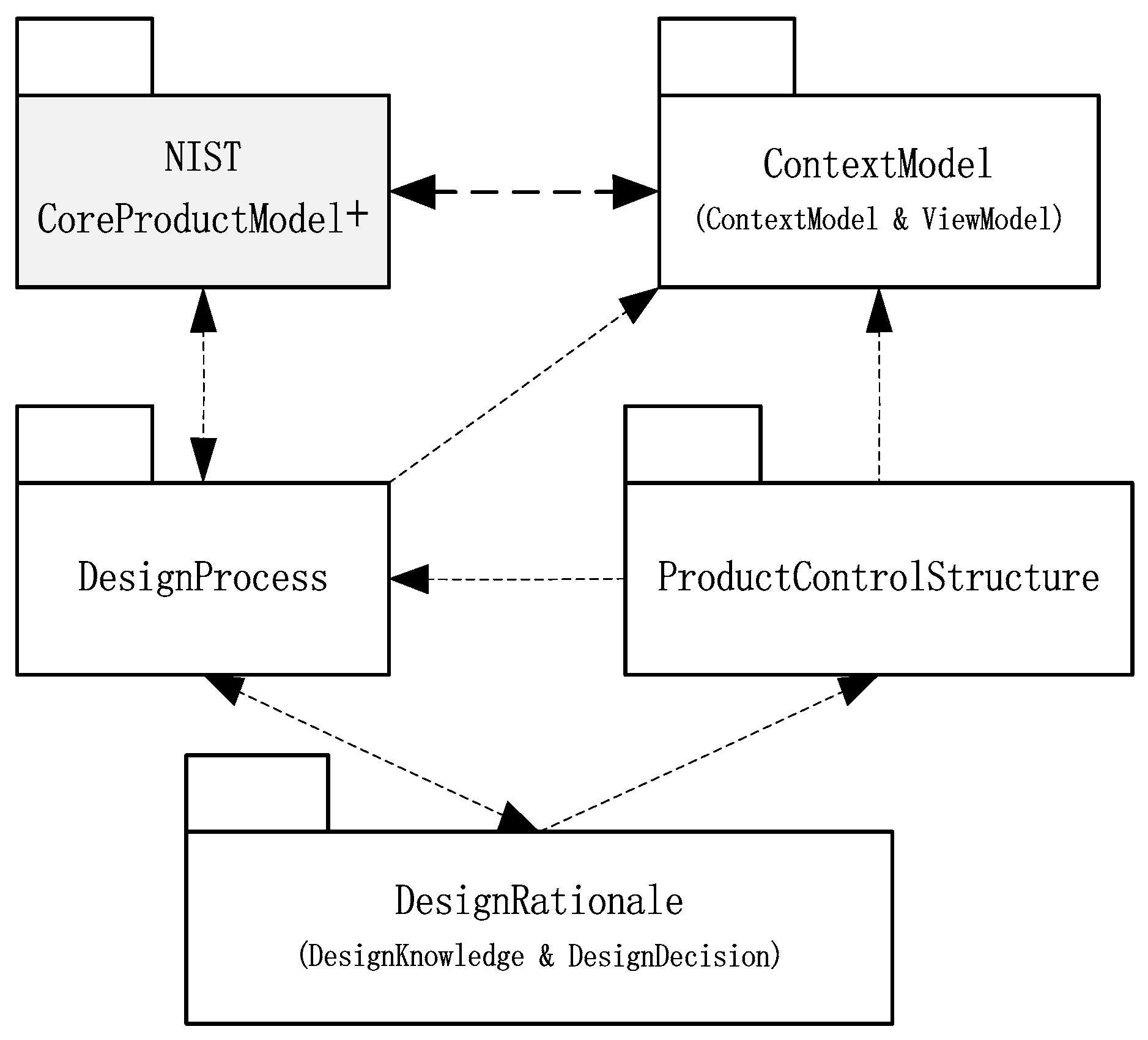
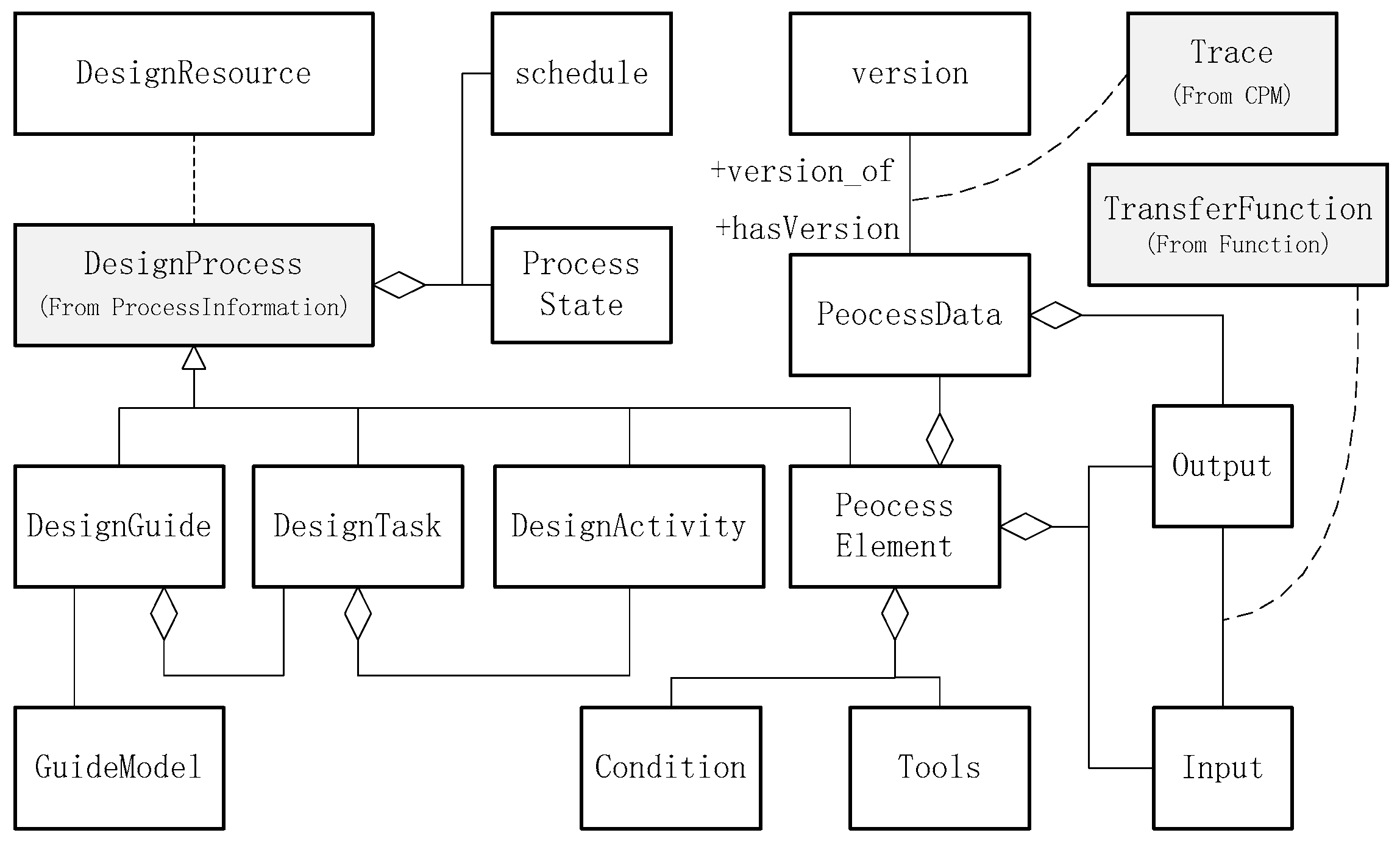
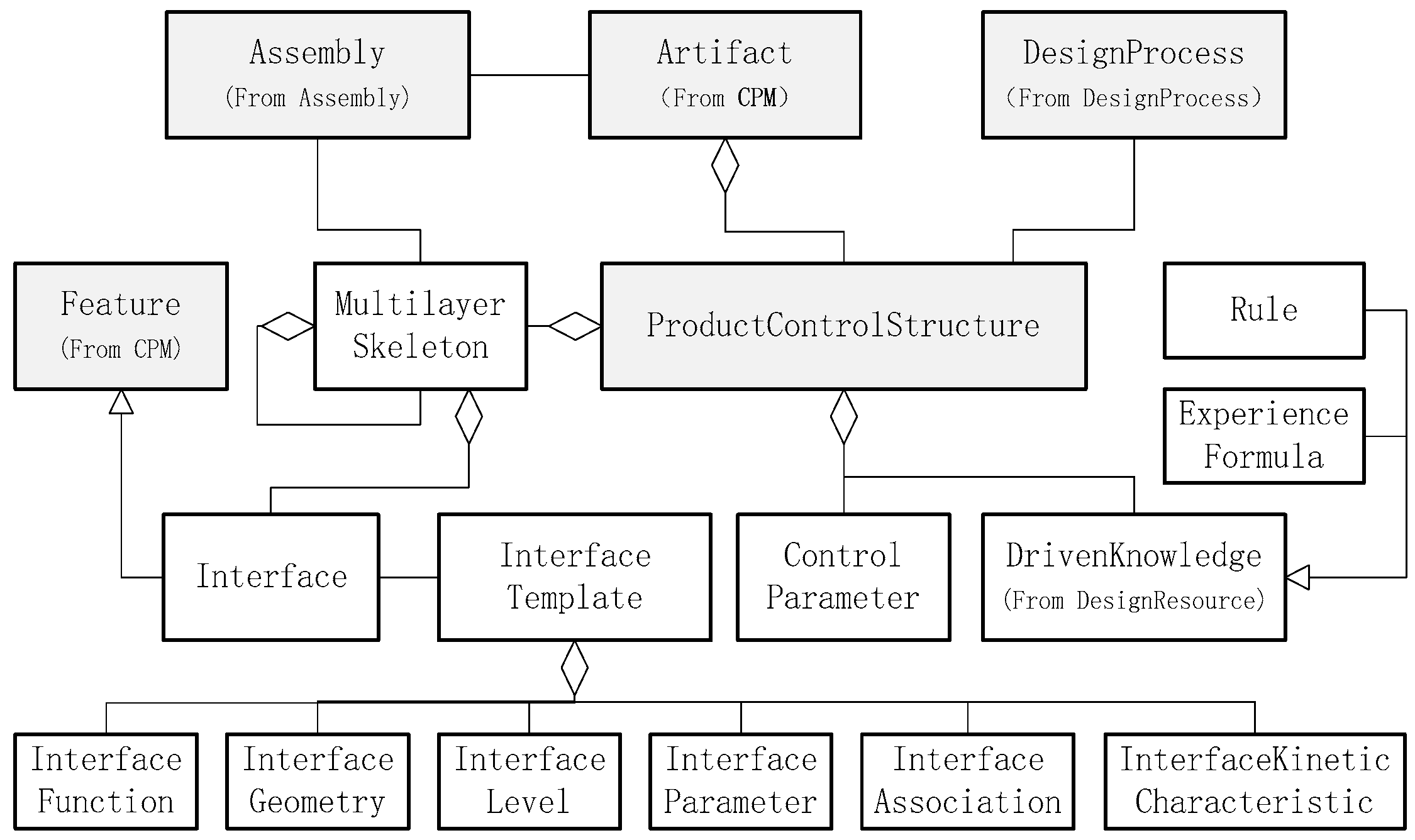
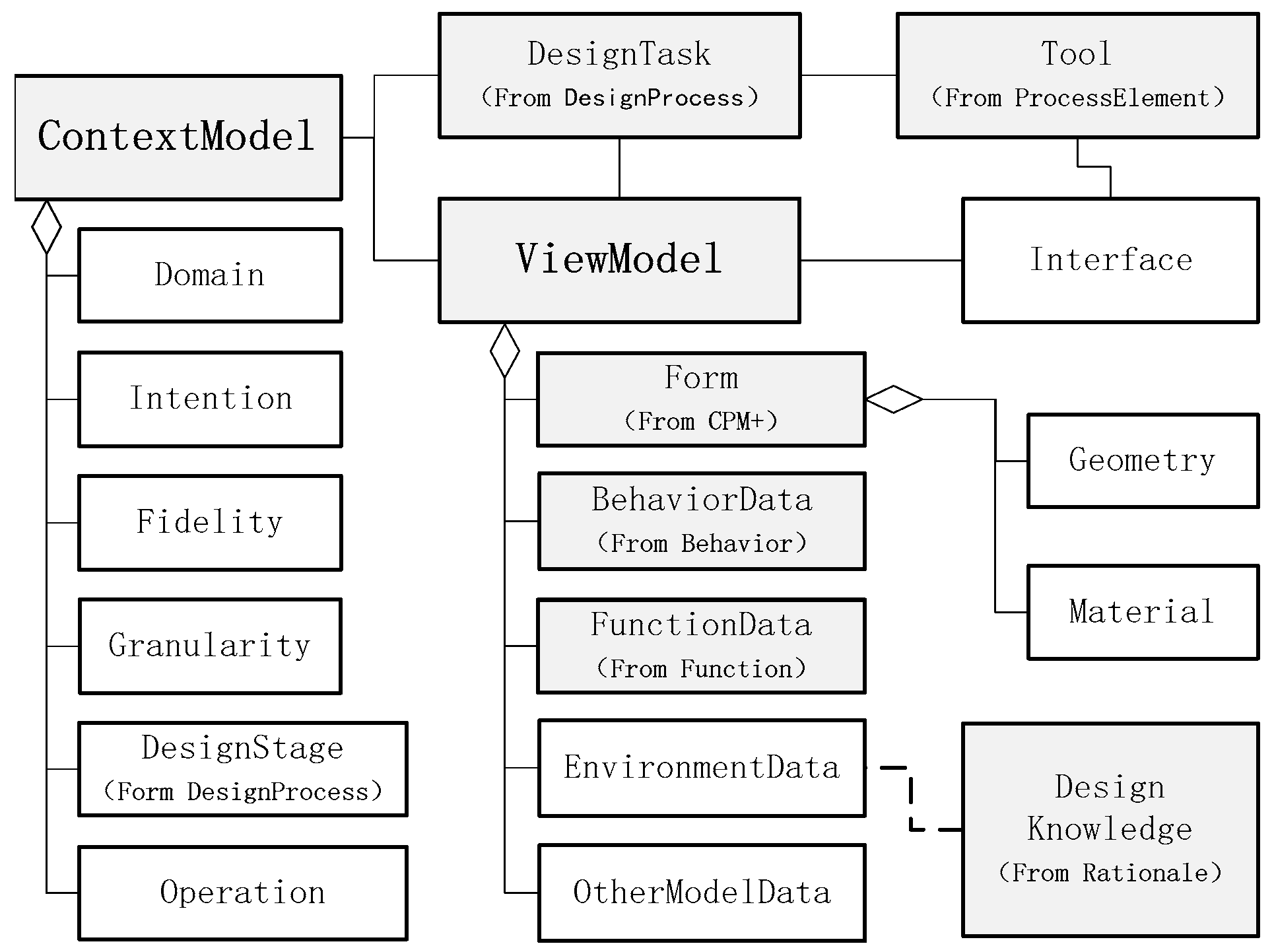
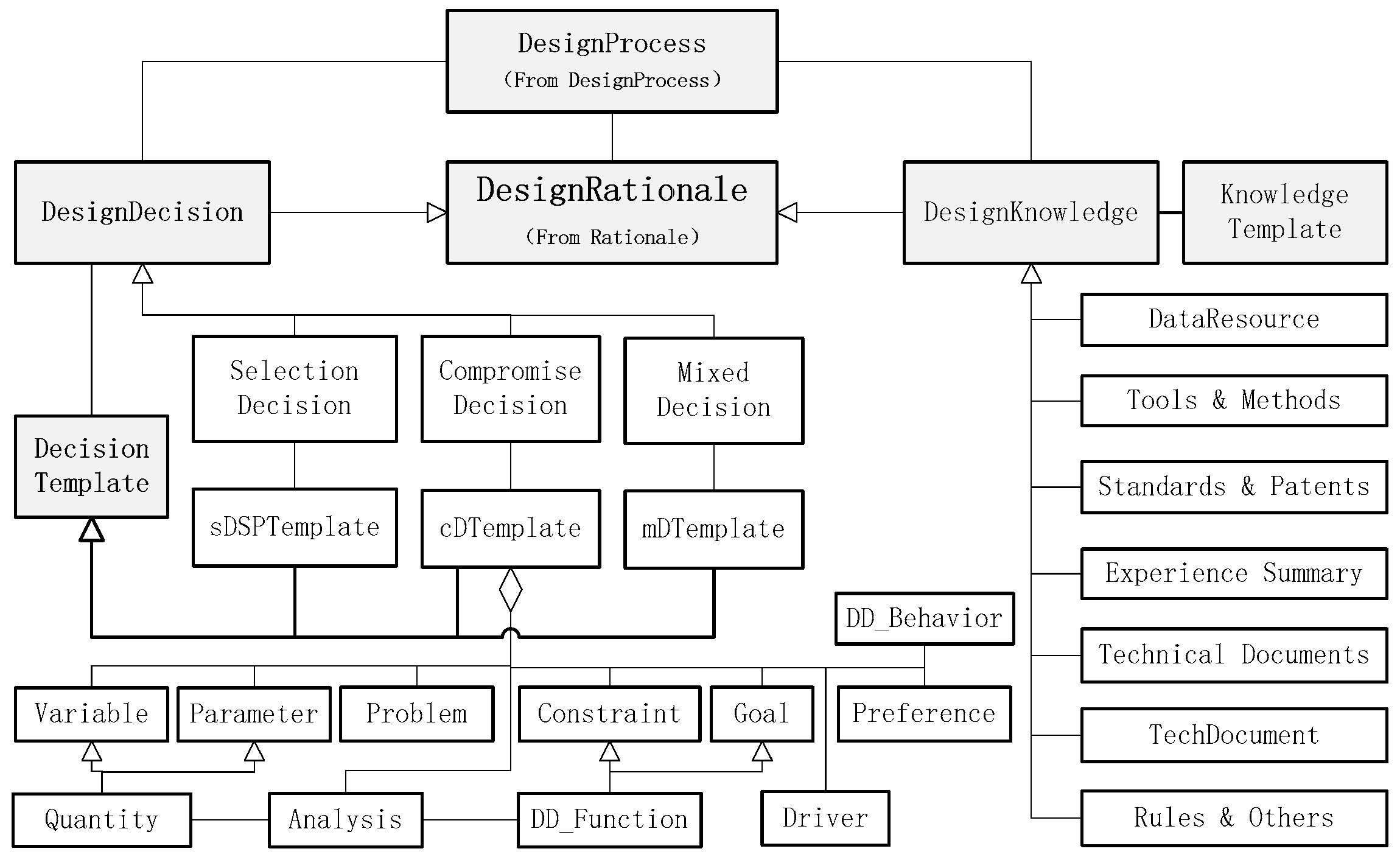
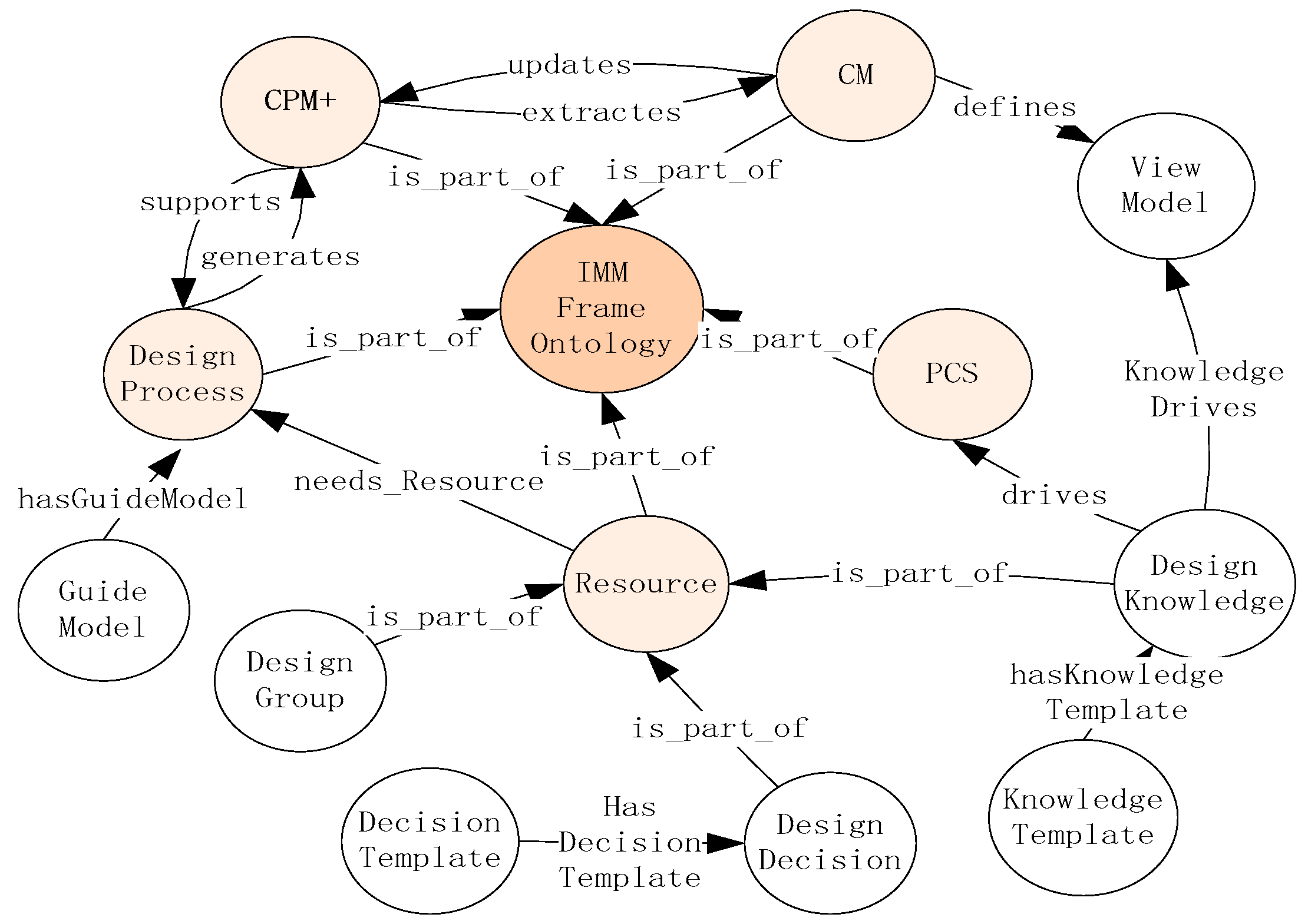
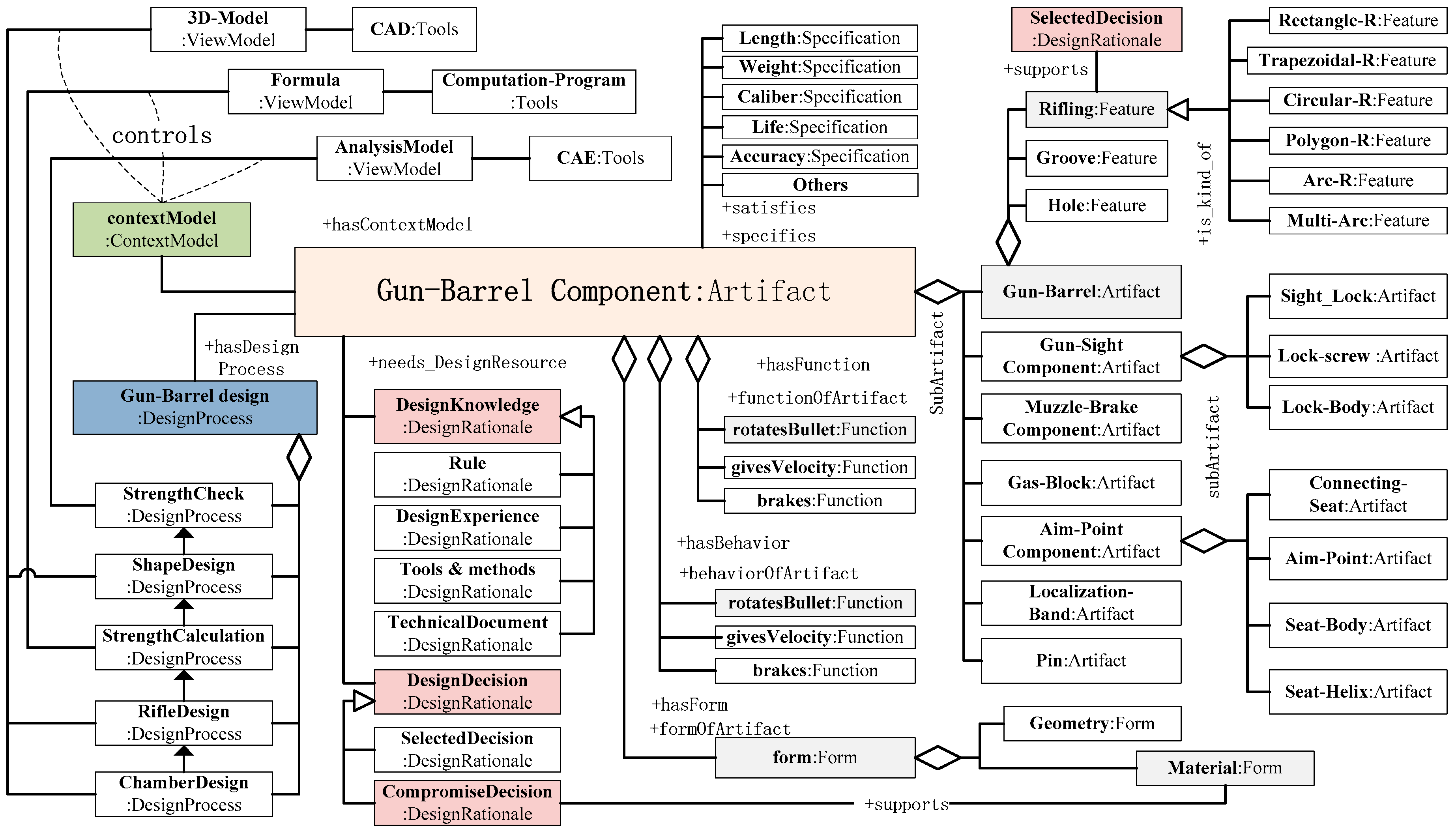
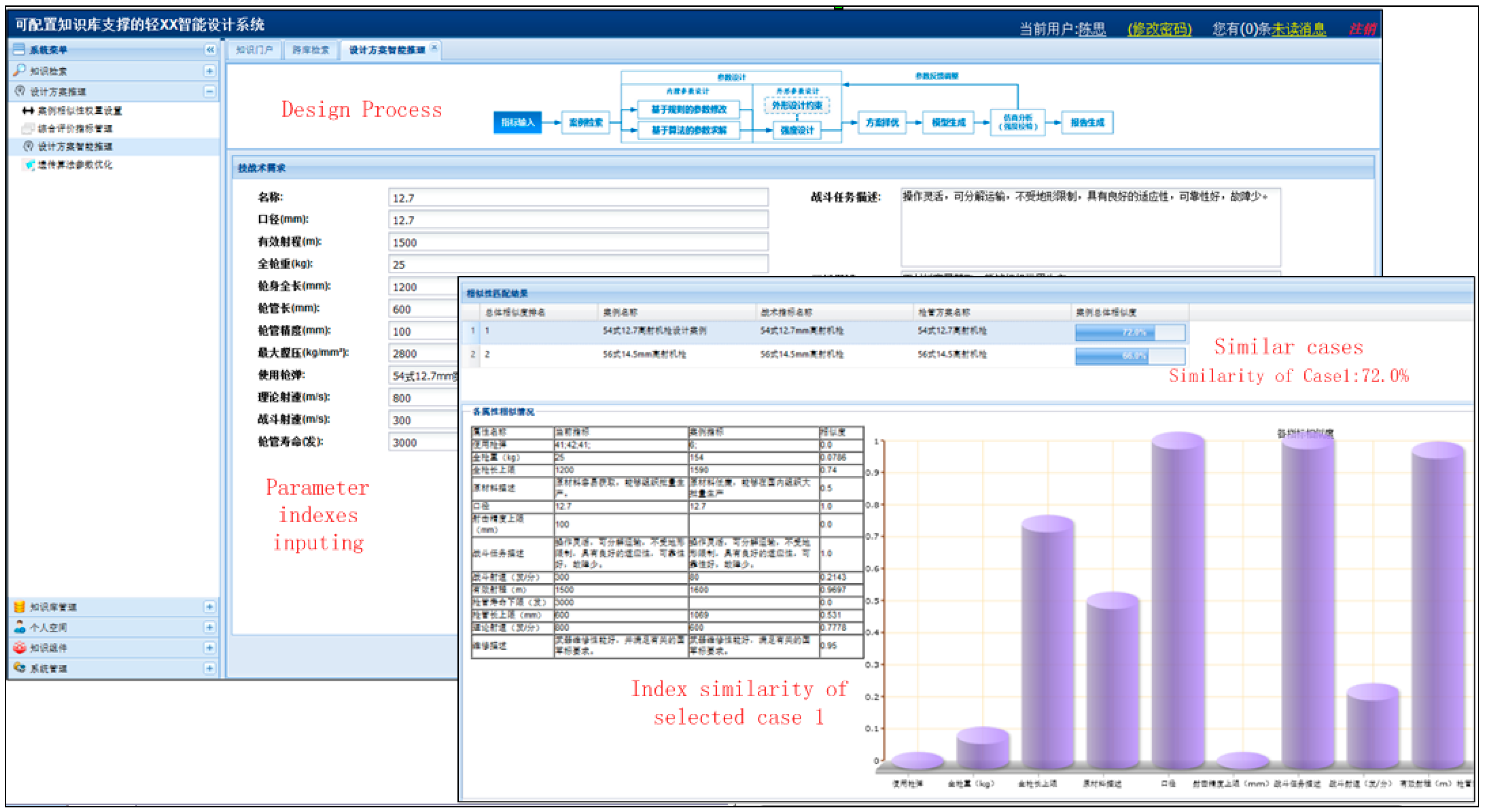
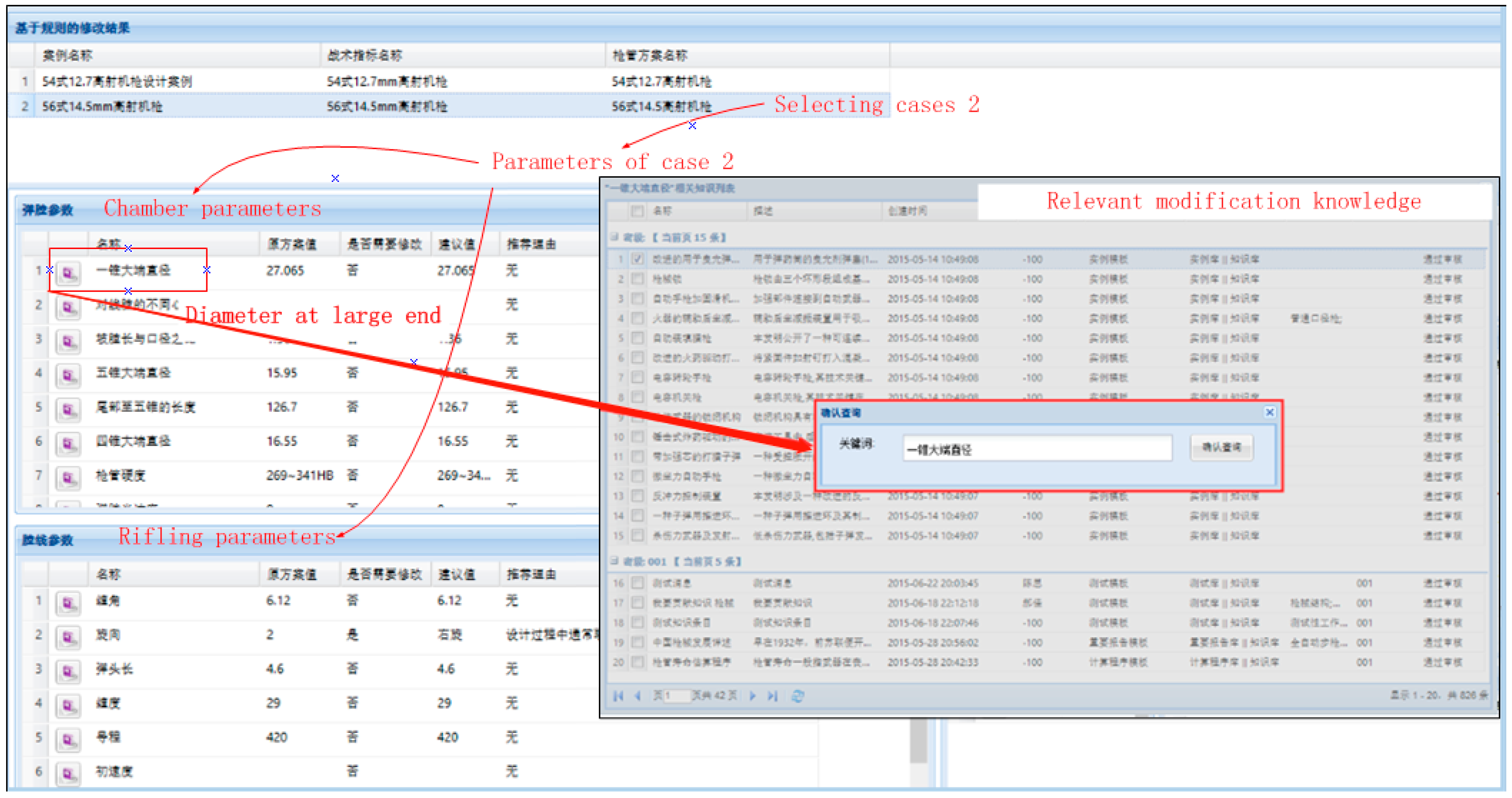
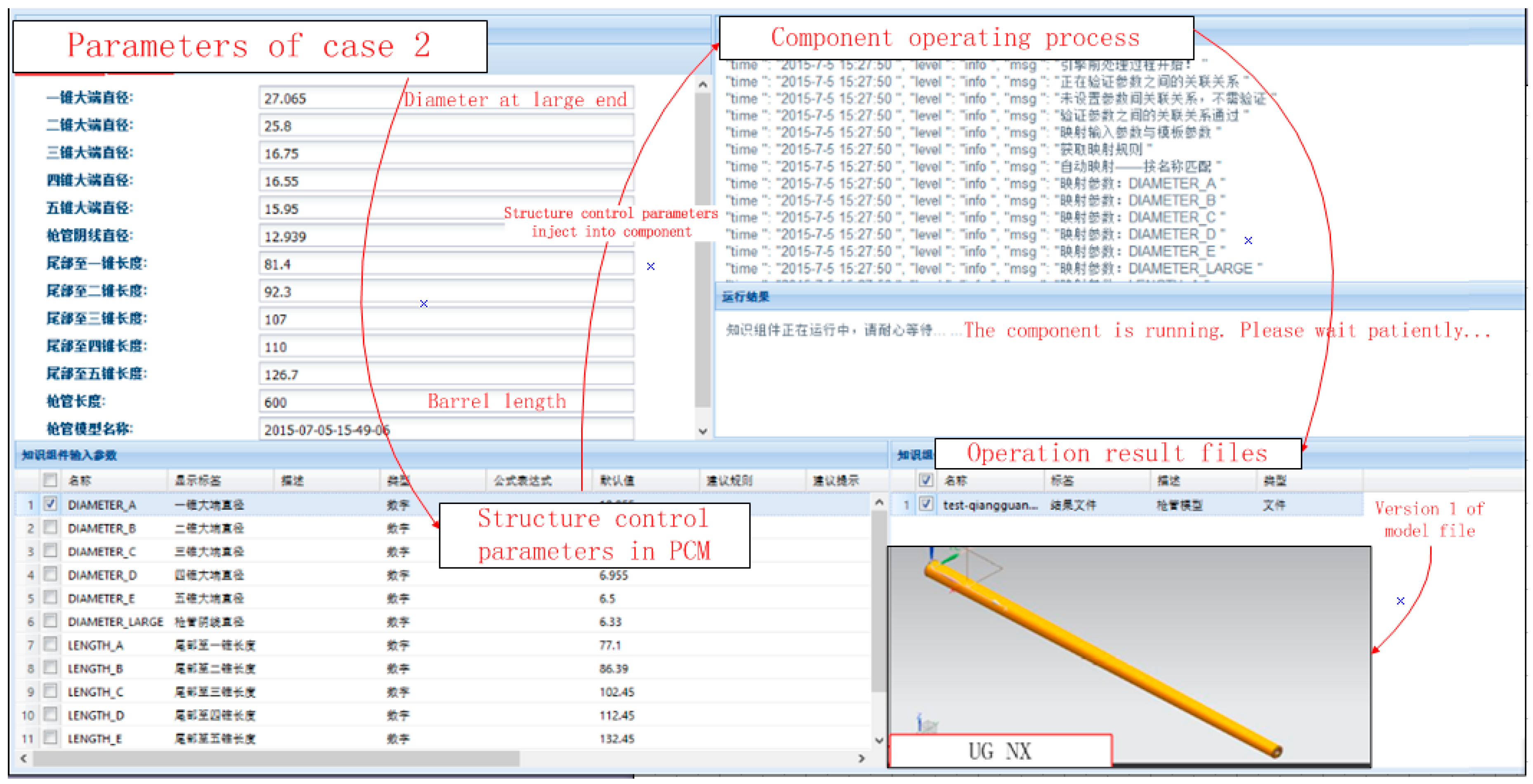
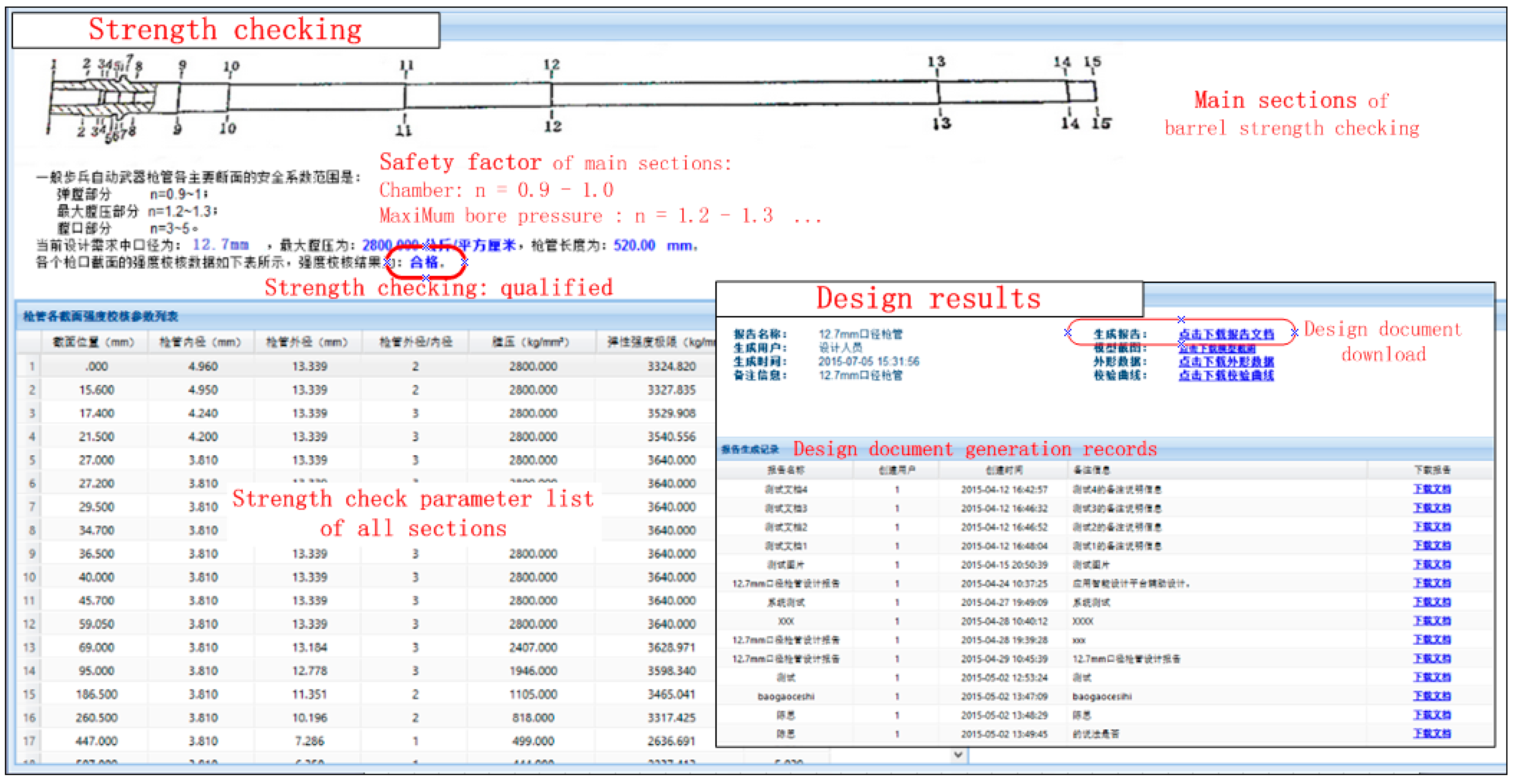
| Slot Name | Definition | Type |
|---|---|---|
| superclass/subclass_of | Link two concepts with super-class/subclass relationship | Instance |
| hasPart/is_part_of | Link two concepts with composition relationship | Instance |
| supports | Link DesignKnowledge and DesignDecision to DesignProcess | Instance |
| drives | Link a DesignKnowledge to a ProductControlStructure | Instance |
| updates | Link a ViewModel to a CoreProductModel+ | Instance |
| is_belong_to | Link a Parameter (parameter set) to a Structure | Instance |
| is_decided_on | Link a Parameter (parameter set) to a Function | Instance |
| needsMaterial | Link a Structure to a Material | Instance |
| has_restraint_for | Link a Function to a Structure Link a Function to a Behavior | Instance |
| is_restrained_by | Link a Behavior to a Function | Instance |
| is_completed_by | Link a Structure to a DesignTask | Instance |
| is_comprised_by | Link a DesignProcess to a DesignGuide | Instance |
| hasVersion/version_of | Link a ProcessData to a Version(Versions) | Instance |
| hasMultilayerSkeleton | Link a PCS to a MultilayerSkeleton | Instance |
| hasControlParameter | Link a PCS to ControlParameters | Instance |
| hasDrivenKnowledge | Link a PCS to DrivenKnowledge | Instance |
| hasDecisionTemplate | Link a Decision to a DecisionTemplate | Instance |
| hasKnowledgeTemplate | Link a DesignKnowledge to a KnowledgeTemplates | Instance |
| Slot Name | Definition | Type |
|---|---|---|
| IMMInfo | Information of IMM | String |
| name | Name of an instance | String |
| type | Type of an instance | String |
| information | Information of an instance | String |
| description | Description of an instance | String |
| processInfo | Information of a design process | String |
| PCSInfo | Information of PCS | String |
| skeletonInfo | Information of a multilayer skeleton | String |
| interfaceTemplateInfo | Information of a interface template | String |
| KTemplateInfo | Information of a knowledge template | String |
| knowledgeInfo | Information of a piece of knowledge | String |
| DTemplateInfo | Information of a decision template | String |
| functionInfo | Information of a Function | String |
| behaviorInfo | Information of a Behavior | String |
| structureInfo | Information of a Structure | String |
| materialInfo | Information of a Material | String |
| RuleNo | Rule Description |
|---|---|
| Rule1 | Each object and relationship has an Information attribute |
| Rule2 | Information is a container consisting of textual description slot, textual documentation string and properties slot |
| Rule3 | A properties slot that contains a set of attribute-value pairs stored as a string |
| Rule4 | Each object and relationship, except for the abstract and utility classes, has an attribute called type, the value of which is a string that acts as a symbolic classifier |
| Rule5 | Constraint is a specific shared property of a set of entities that must hold in all cases |
| Rule6 | There are associations existing between Specification and the Artifact that results from it |
| Rule7 | There are associations existing between a Flow and its source and destination Artifacts and its input and output Functions |
| Rule8 | There are associations existing between an Artifact and its Features |
| Rule9 | Function, Form and Behavior aggregate into Artifact |
| Rule10 | Function and Form aggregate into Feature |
| Rule11 | Geometry and Material aggregate into Form |
| Rule12 | Requirements aggregate into Specification |
| Selected Requirement | Type | Value |
|---|---|---|
| Caliber (mm) | numerical | 12.7 |
| Effective range (m) | numerical | 1500 |
| Whole weight limit(kg) | numerical | 25 |
| Whole length limit (mm) | numerical | 120 |
| Barrel length limit (mm) | numerical | 600 |
| Initial velocity limit (m/s) | numerical | 750 |
| Theoretical rate of fire (round /min) | numerical | 800 |
| Fighting rate of fire (round /min) | numerical | 300 |
| Used bullet | containing | Armor-piercing incendiary, type 54, 12.7 mm |
| Fight task | textual | Flexible operation, detachable transport, high reliability and low failure rate |
| Material | textual | Easy access, enough strength and low cost |
| Maintenance | textual | Standards conformance and good maintainability |
| DTemplateInfo | Name | Type | Object | OtherInfo | |
| Strength calculation | compromise decision | Barrel | … | ||
| Parameter | Name | Type | Unit | Value | Input/Output |
| σs | numerical | N/mm2 | 50 | Input | |
| BL | numerical | mm | 600 | Input | |
| P–L curve | Matlab file | Unit | P–L.mat | Input | |
| r1 | numerical | mm | 12.7 | Input | |
| FG | numerical | — | FG =ω1*r2 +ω2*W | Input | |
| Variable | Name | Type | Unit | Value | Behavior |
| r2C | numerical | mm | Output | Output | |
| r2MBP | numerical | mm | Output | Output | |
| r2M | numerical | mm | Output | Output | |
| Constraint | Name | Type | Constraint description | ||
| n | hard | 0.9–1 in chamber section | |||
| 1.2–1.3 in MBP section | |||||
| 3–5 in muzzle section | |||||
| Goal | Name | Type | Description | Weight | Formula |
| r2 | Max | Max r2 | ω1 | r2 = f (r1,σs, n, p) | |
| W | Min | Min weight | ω2 | W = f (r2, r1, BL, ST, ρ) | |
| Analysis | Algorithm of multi-objective analysis, Process of barrel strength calculation | ||||
| Driver | Matlab for P–L curve, Code for barrel strength calculation | ||||
| Preference | Design rule 1, Design rule 2, … | ||||
| History | Previous experience | ||||
| Response | Optional parameters | ||||
| Nomenclatures | Description |
|---|---|
| BL | Barrel length (mm) |
| r2C | External diameter in section of chamber (mm) |
| r2MBP | External diameter in section of MBP (mm) |
| r2M | External diameter in section of muzzle (mm) |
| FG | Goal function |
| n | Safety Factor |
| W | Barrel weight (kg) |
| ω1 | Weight associated with the r2 goal |
| ω2 | Weight associated with the W goal |
| r1 | Internal diameter (mm) |
| p | Pressure of the gunpowder gas in the chamber (kpa) |
| ρ | Material density (g/cm3) |
| σs | Material yield limit (N/mm2) |
| ST | The shape type of the rifling cross section |
| P–L | Calculated bore pressure curve |
© 2019 by the authors. Licensee MDPI, Basel, Switzerland. This article is an open access article distributed under the terms and conditions of the Creative Commons Attribution (CC BY) license (http://creativecommons.org/licenses/by/4.0/).
Share and Cite
Yu, C.; Zhang, F.-p.; Butt, S.I.; Yan, Y.; Lv, W. OntoIMM: An Ontology for Product Intelligent Master Model. Appl. Sci. 2019, 9, 2553. https://doi.org/10.3390/app9122553
Yu C, Zhang F-p, Butt SI, Yan Y, Lv W. OntoIMM: An Ontology for Product Intelligent Master Model. Applied Sciences. 2019; 9(12):2553. https://doi.org/10.3390/app9122553
Chicago/Turabian StyleYu, Cong, Fa-ping Zhang, Shahid I. Butt, Yan Yan, and Wu Lv. 2019. "OntoIMM: An Ontology for Product Intelligent Master Model" Applied Sciences 9, no. 12: 2553. https://doi.org/10.3390/app9122553
APA StyleYu, C., Zhang, F.-p., Butt, S. I., Yan, Y., & Lv, W. (2019). OntoIMM: An Ontology for Product Intelligent Master Model. Applied Sciences, 9(12), 2553. https://doi.org/10.3390/app9122553





